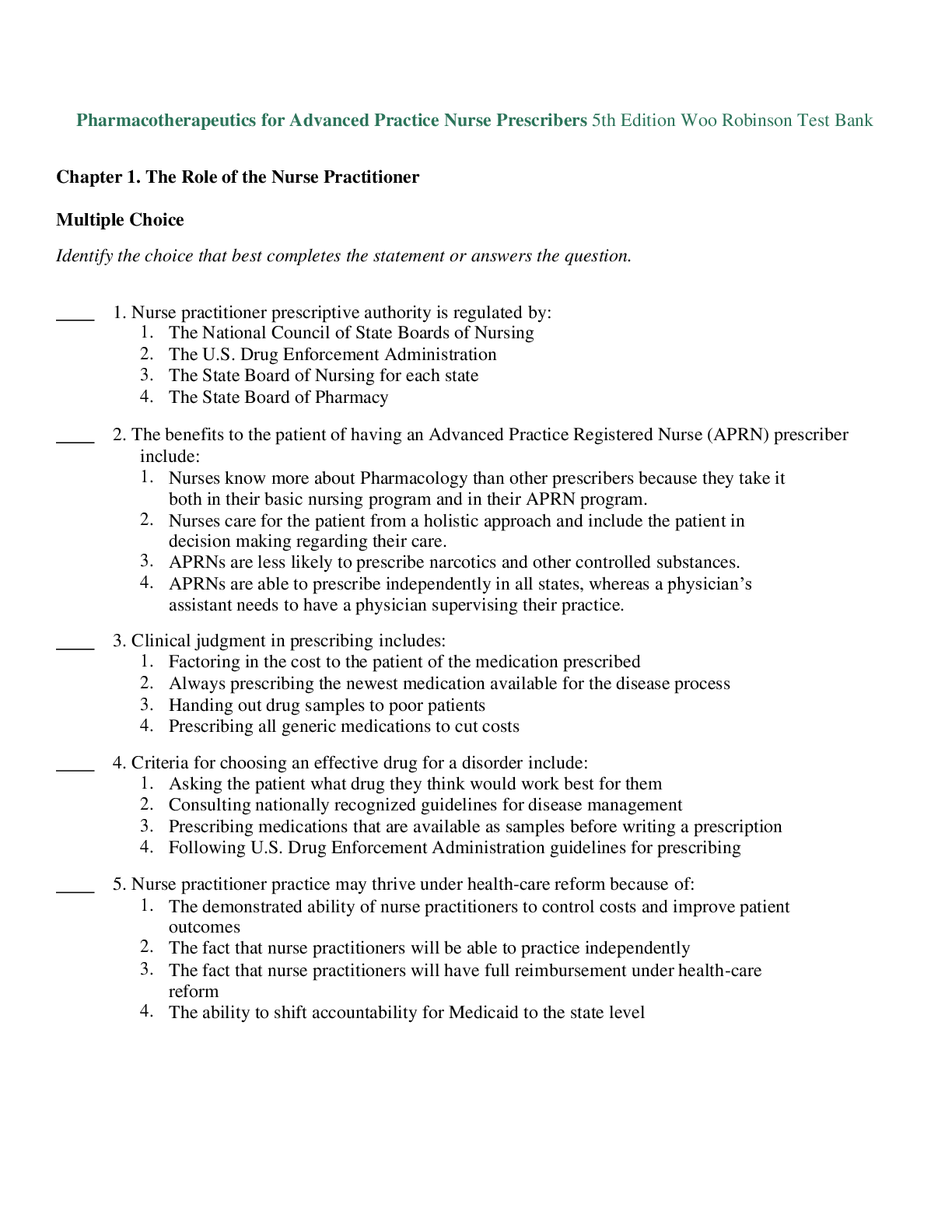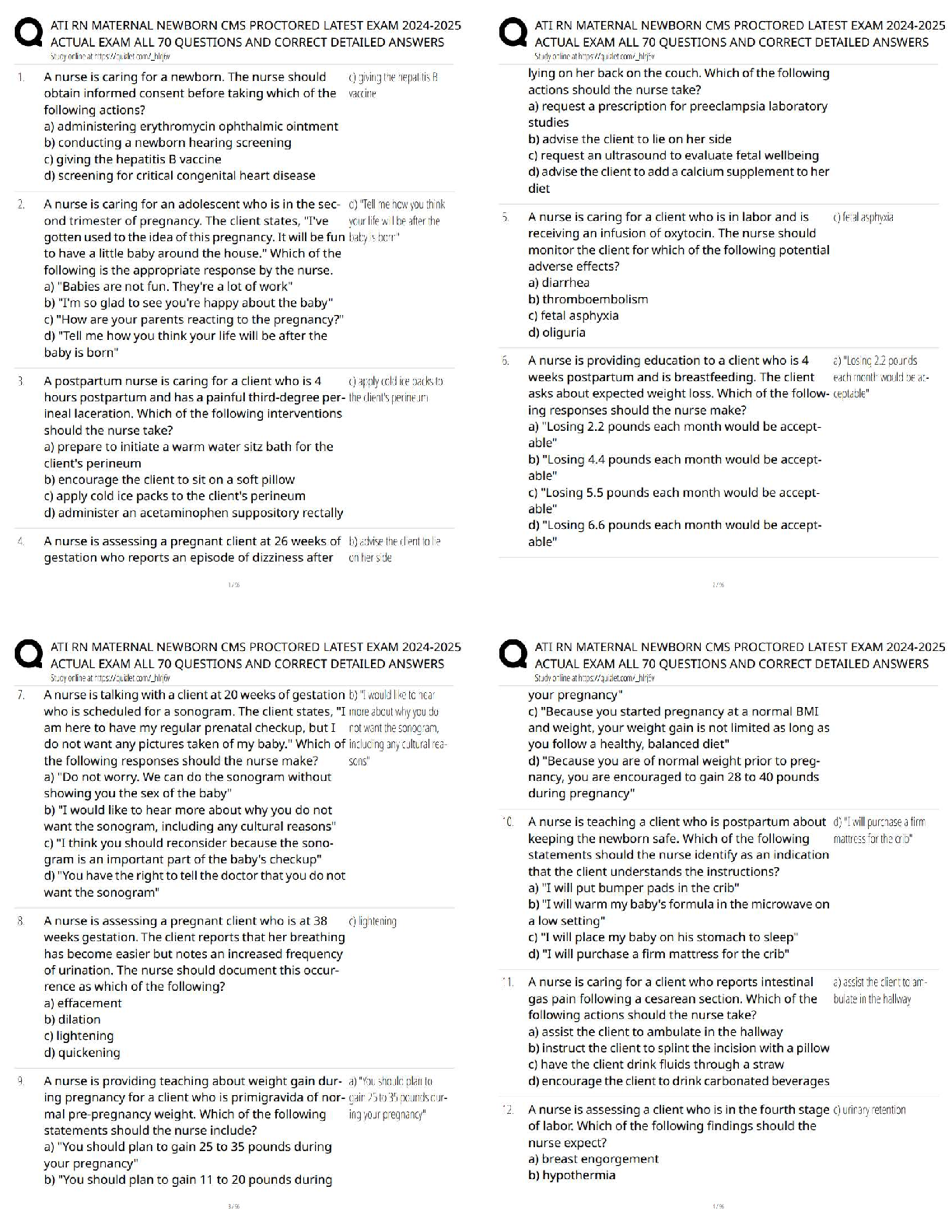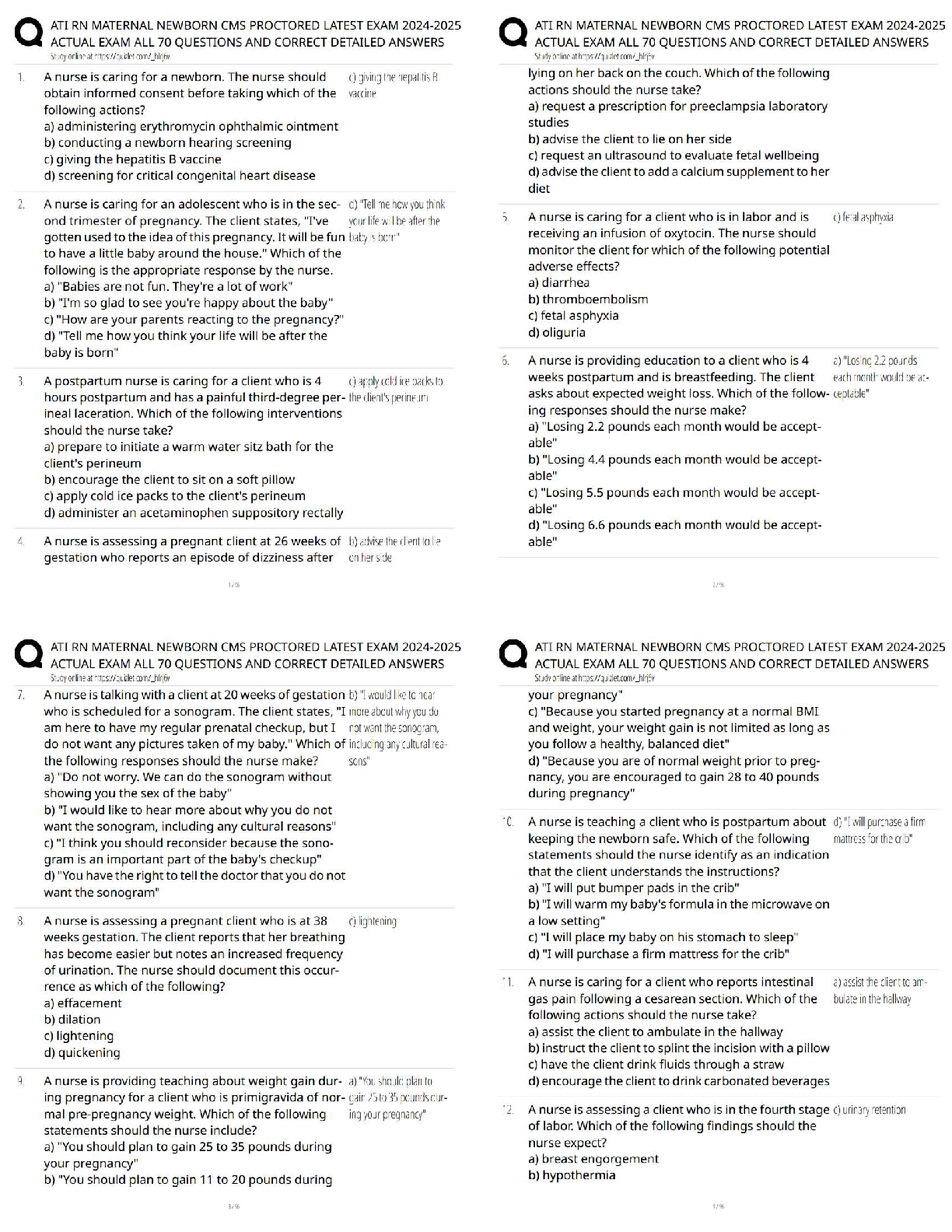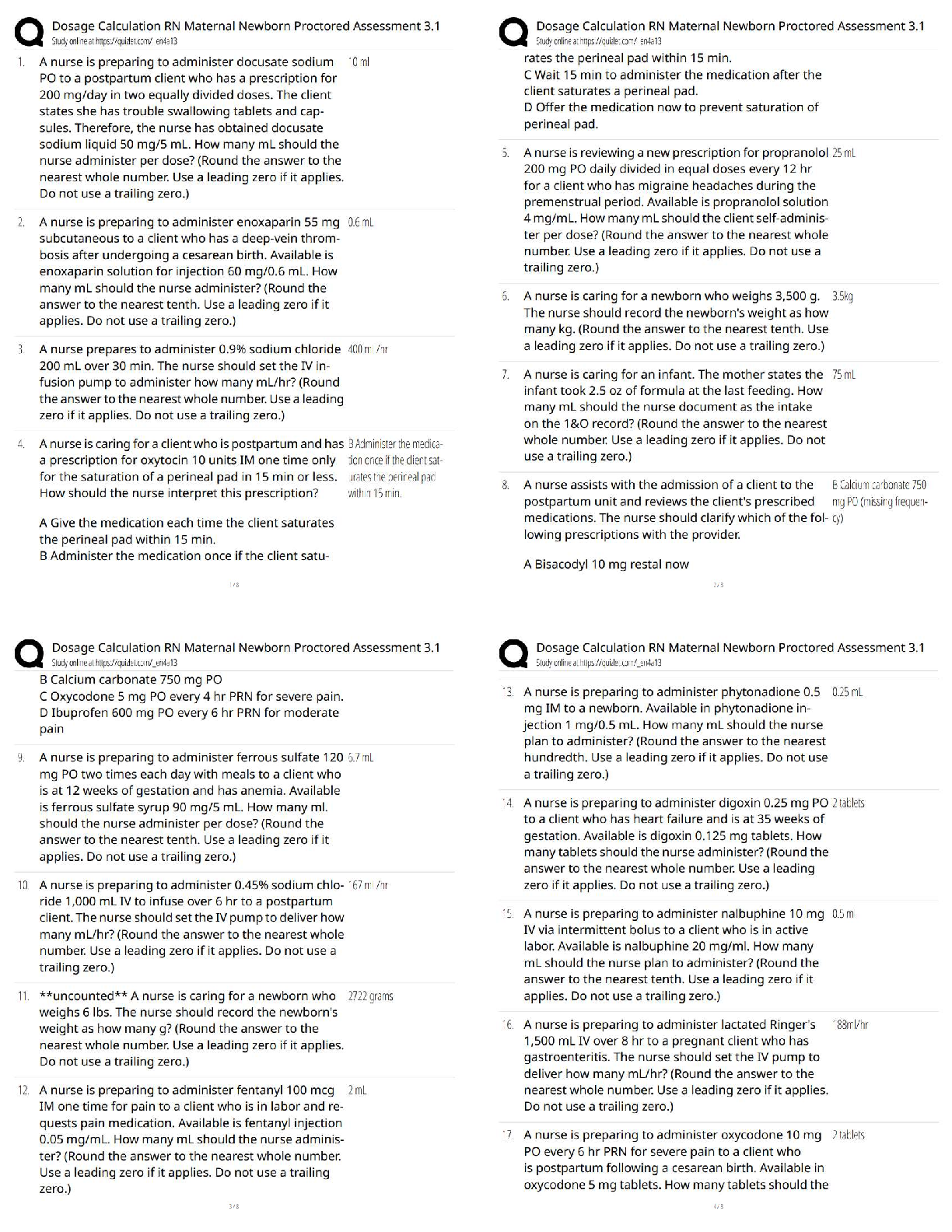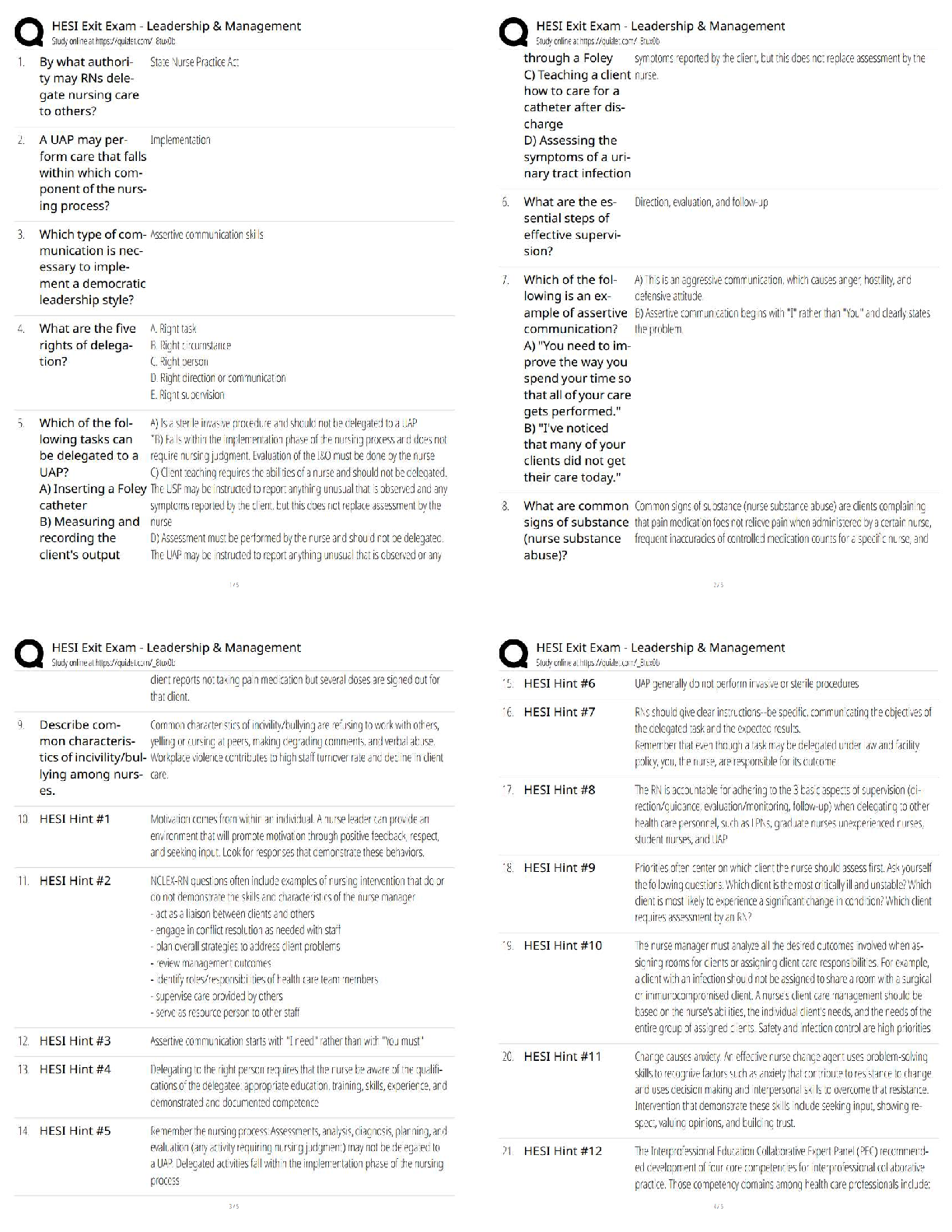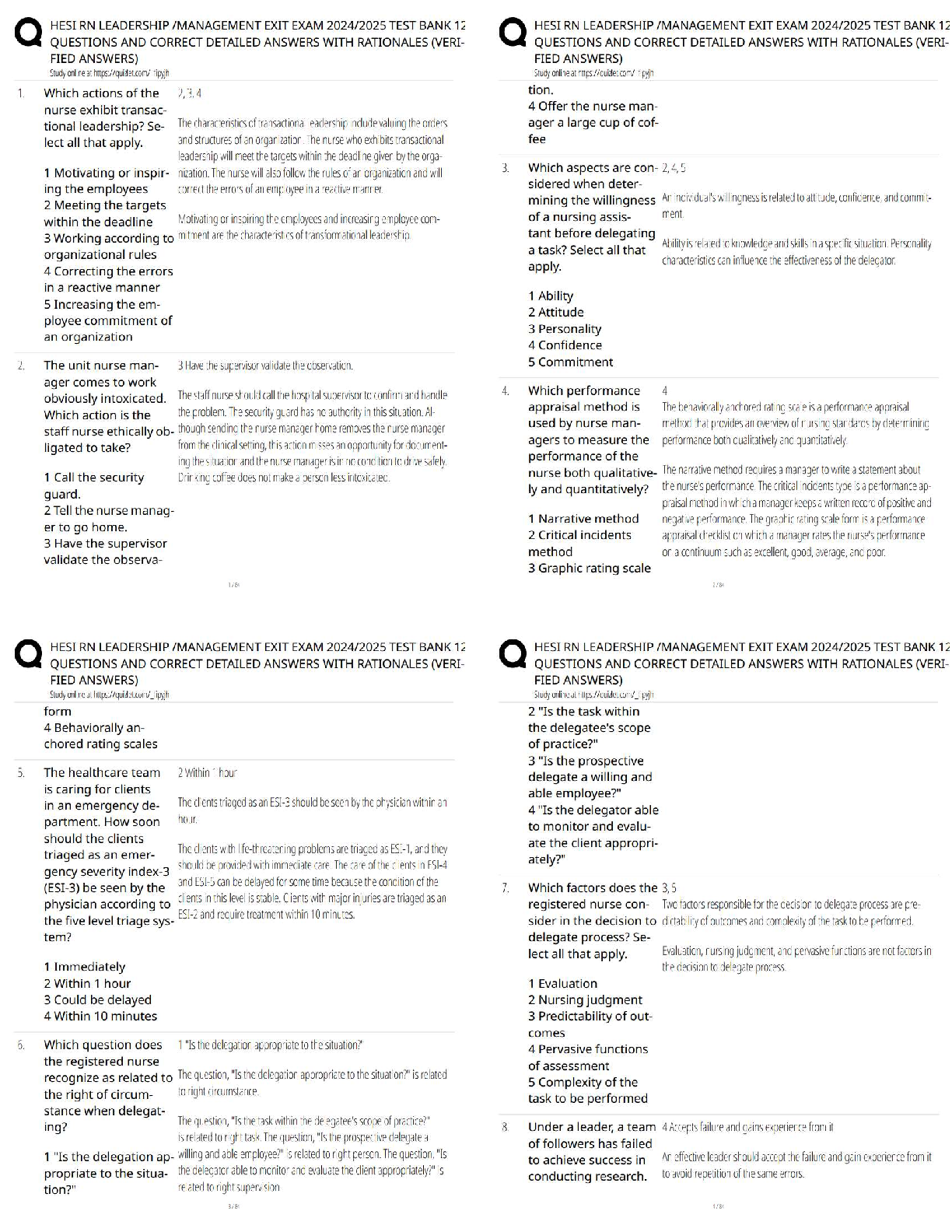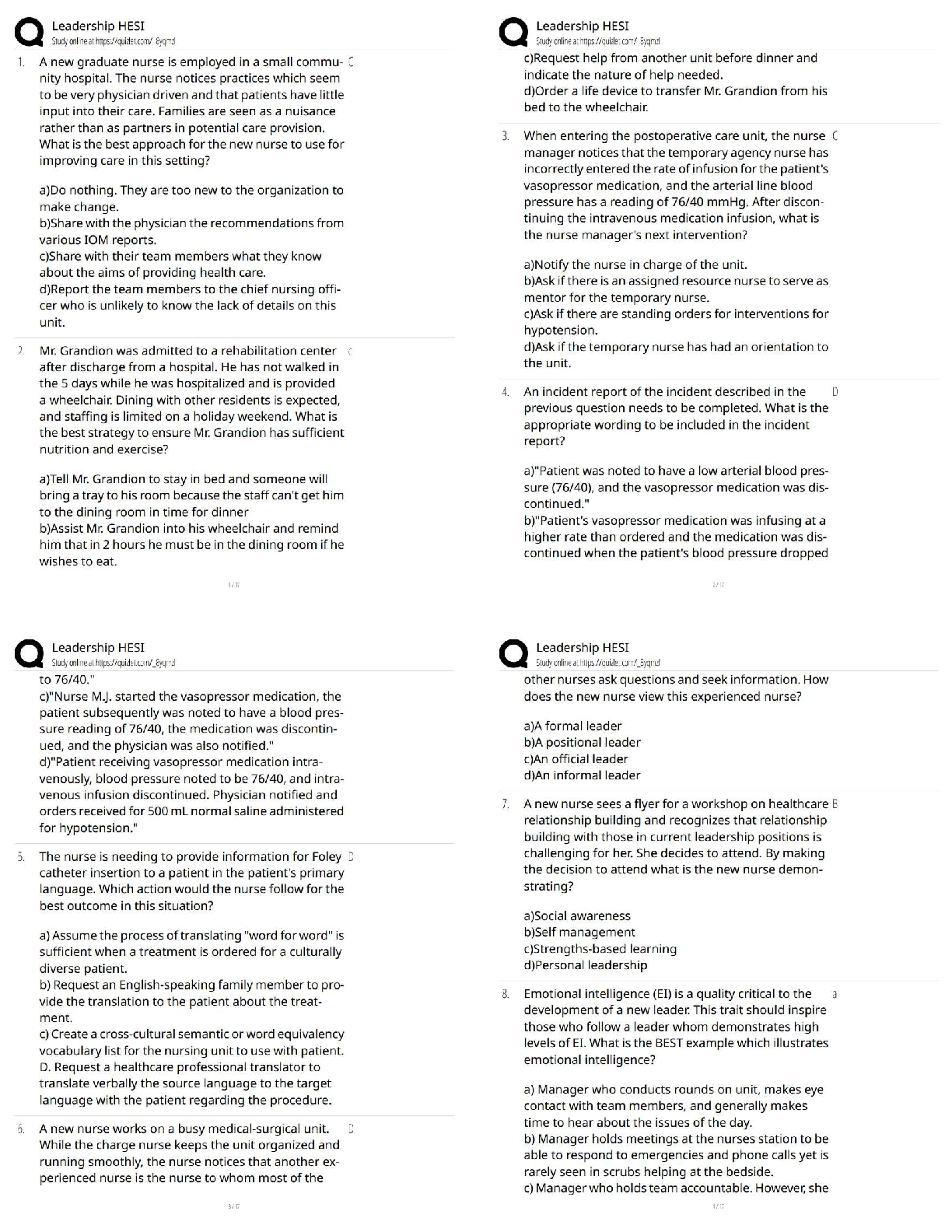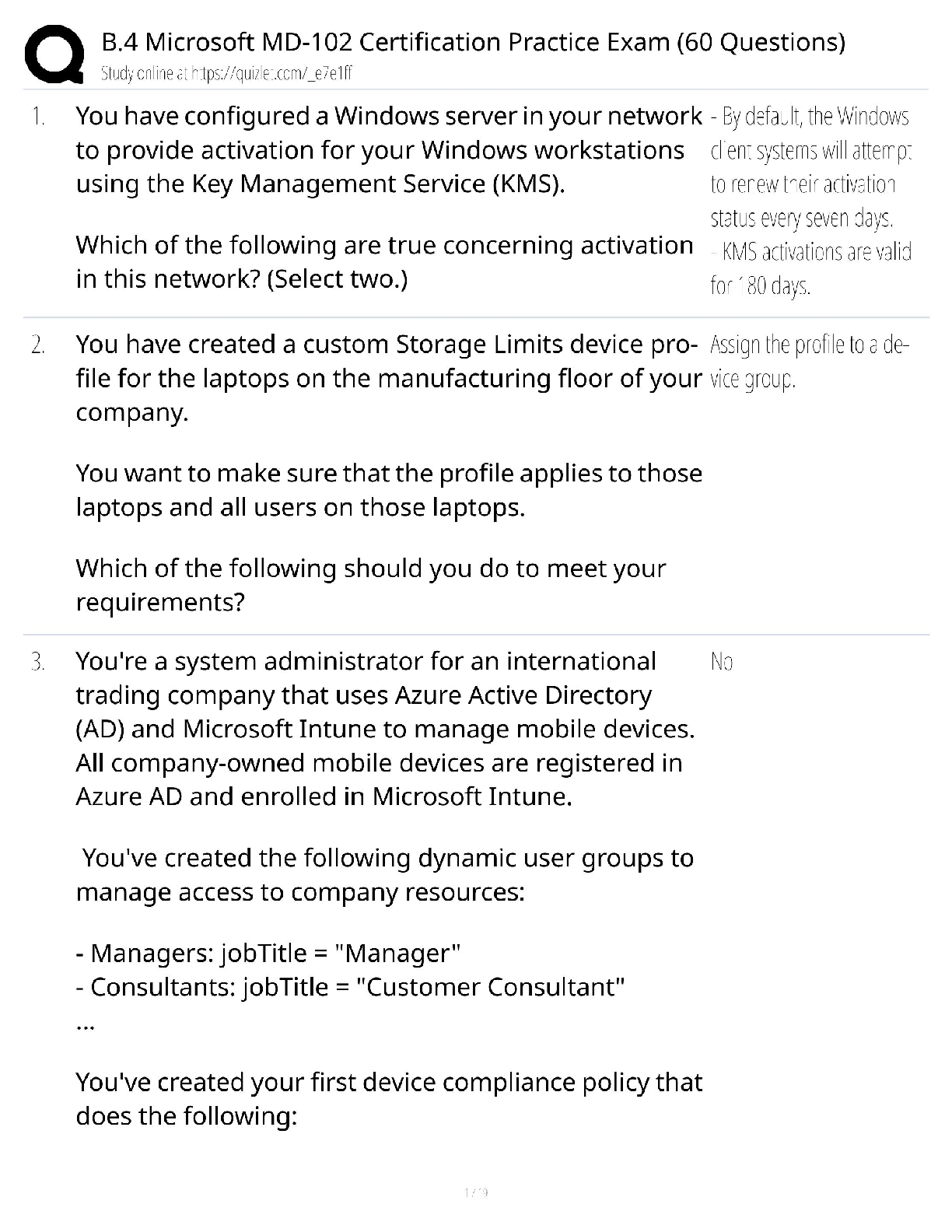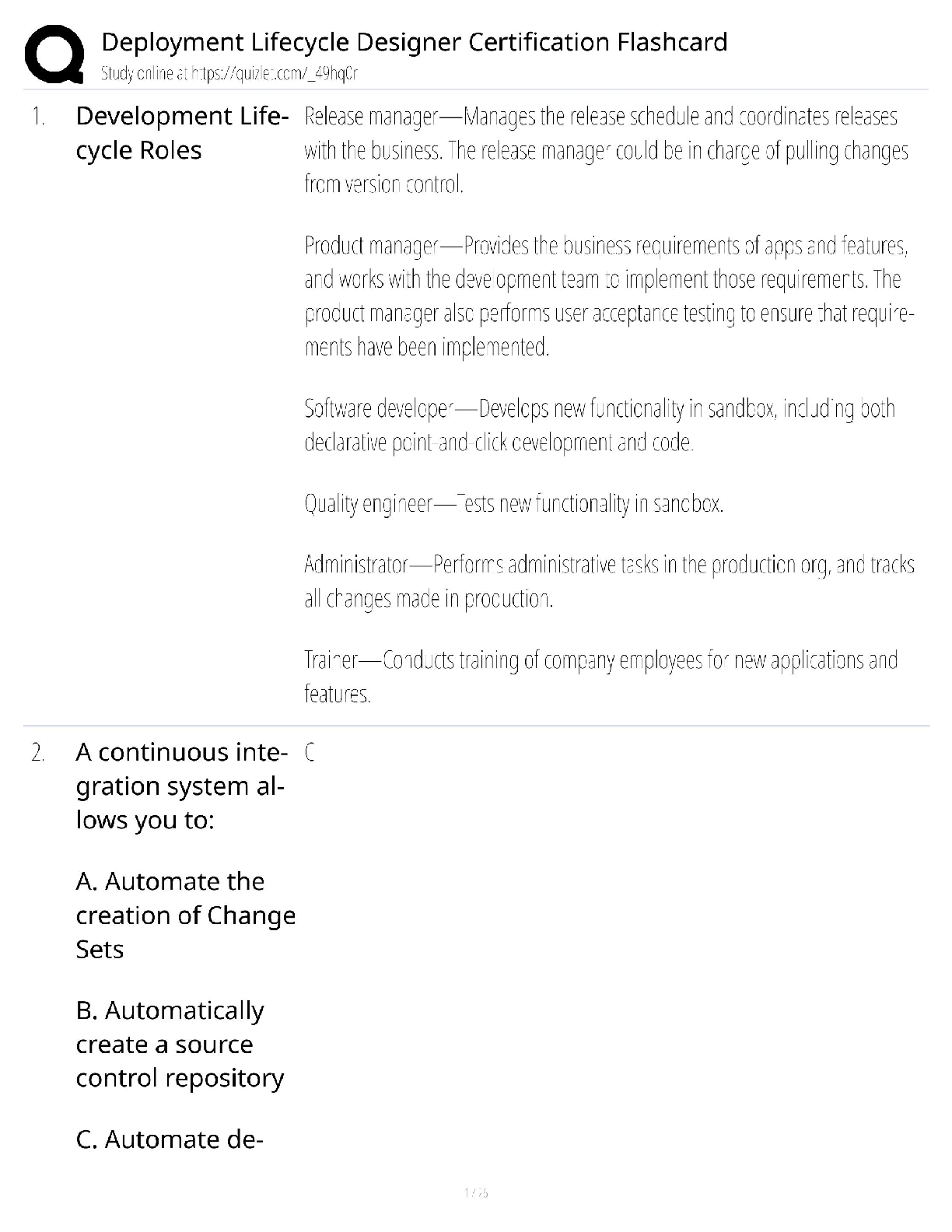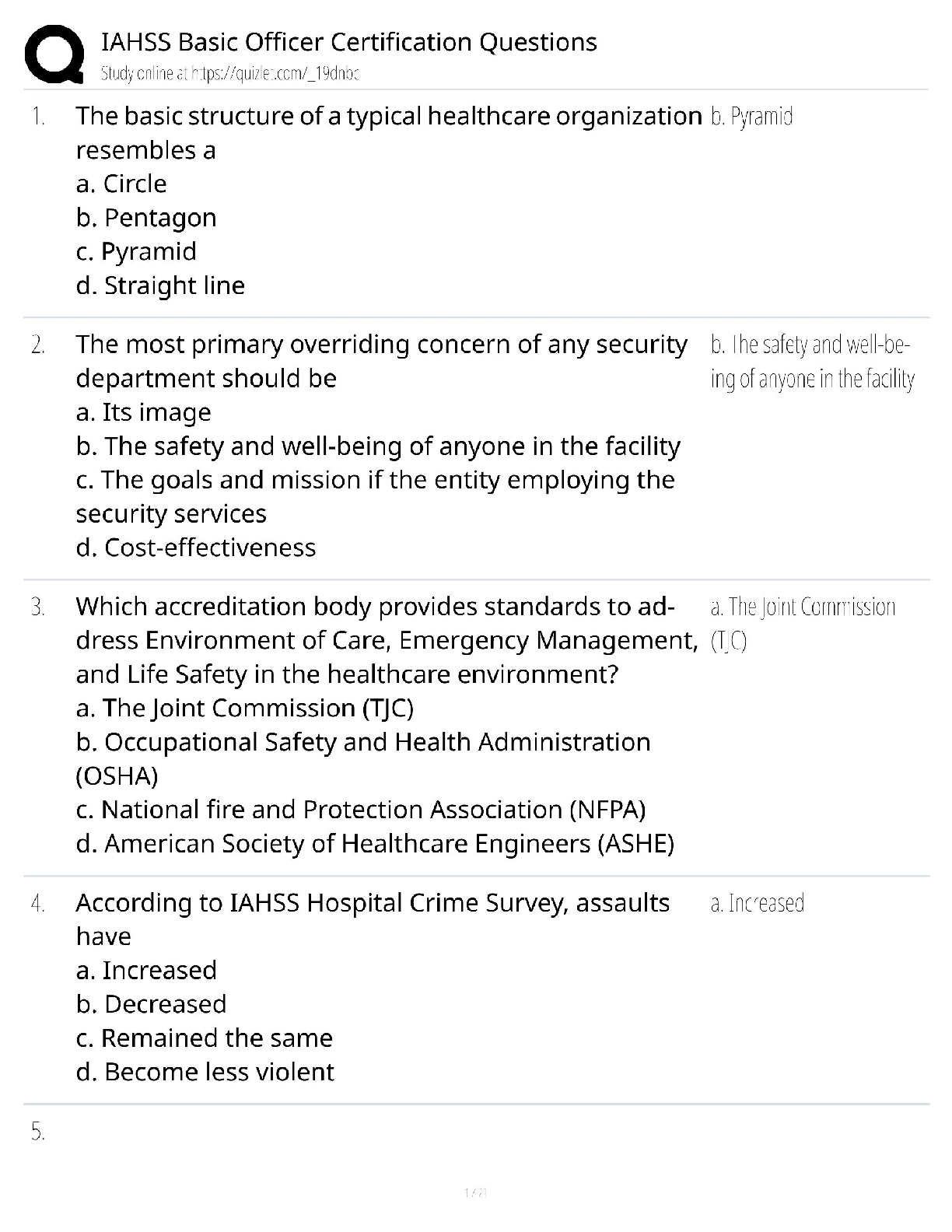Business Analytics > QUESTIONS & ANSWERS > Chapter 10: Business Analytics_ Data Analysis _ Decision Making (All)
Chapter 10: Business Analytics_ Data Analysis _ Decision Making
Document Content and Description Below
1. Data collected from approximately the same period of time from a cross-section of a population are called: a. time series data b. linear data c. cross-sectional data d. historical data 2. Re ... gression analysis asks: a. if there are differences between distinct populations b. if the sample is representative of the population c. how a single variable depends on other relevant variables d. how several variables depend on each other 3. In regression analysis, the variables used to help explain or predict the response variable are called the a. independent variables b. dependent variables c. regression variables d. statistical variables 4. In regression analysis, the variable we are trying to explain or predict is called the a. independent variable b. dependent variable c. regression variable d. statistical variable e. residual variable 5. In regression analysis, if there are several explanatory variables, it is called: a. simple regression b. multiple regression c. compound regression d. composite regression Copyright Cengage Learning. Powered by Cognero. Page 1 Name: Class: Date: Chapter 10 6. In regression analysis, which of the following causal relationships are possible? a. X causes Y to vary b. Y causes X to vary c. Other variables cause both X and Y to vary d. All of these options 7. is/are especially helpful in identifying outliers. a. Linear regression b. Regression analysis c. Normal curves d. Scatterplots e. Multiple regression 8. Outliers are observations that a. lie outside the sample b. render the study useless c. lie outside the typical pattern of points on a scatterplot d. disrupt the entire linear trend 9. A “fan” shape in a scatterplot indicates: a. unequal variance b. a nonlinear relationship c. the absence of outliers d. sampling error 10. A scatterplot that appears as a shapeless mass of data points indicates: a. a curved relationship among the variables b. a linear relationship among the variables c. a nonlinear relationship among the variables d. no relationship among the variables Copyright Cengage Learning. Powered by Cognero. Page 2 Name: Class: Date: Chapter 10 11. Correlation is a summary measure that indicates: a. a curved relationship among the variables b. the rate of change in Y for a one unit change in X c. the strength of the linear relationship between pairs of variables d. the magnitude of difference between two variables 12. A correlation value of zero indicates. a. a strong linear relationship b. a weak linear relationship c. no linear relationship d. a perfect linear relationship 13. The correlation value ranges from a. 0 to +1 b. –1 to +1 c. –2 to +2 d. -Y to +Y 14. The covariance is not used as much as the correlation because a. is not always a valid predictor of linear relationships b. it is difficult to calculate c. it is difficult to interpret d. all of these options 15. A single variable X can explain a large percentage of the variation in some other variable Y when the two variables are: a. mutually exclusive b. inversely related c. directly related d. highly correlated e. None of the above Copyright Cengage Learning. Powered by Cognero. Page 3 Name: Class: Date: Chapter 10 16. The term autocorrelation refers to: a. the analyzed data refers to itself b. the sample is related too closely to the population c. the data are in a loop (values repeat themselves) d. time series variables are usually related to their own past values 17. The weakness of scatterplots is that they: a. do not help identify linear relationships b. can be misleading about the types of relationships they indicate c. only help identify outliers d. do not actually quantify the relationships between variables 18. In linear regression, we fit the least squares line to a set of values (or points on a scatterplot). The distance from the line to a point is called the: a. fitted value b. residual c. correlation d. covariance e. None of these options 19. In linear regression, the fitted value is the: a. predicted value of the dependent variable b. predicted value of the independent value c. predicted value of the slope d. predicted value of the intercept e. None of these options 20. In choosing the “best-fitting” line through a set of points in linear regression, we choose the one with the: a. smallest sum of squared residuals b. largest sum of squared residuals c. smallest number of outliers d. largest number of points on the line e. None of these options Copyright Cengage Learning. Powered by Cognero. Page 4 Name: Class: Date: Chapter 10 21. The standard error of the estimate ( ) is essentially the a. mean of the residuals b. standard deviation of the residuals c. mean of the explanatory variable d. standard deviation of the explanatory variable 22. A multiple regression analysis including 50 data points and 5 independent variables results in 40. The multiple standard error of estimate will be: a. 0.901 b. 0.888 c. 0.800 d. 0.953 e. 0.894 23. Approximately what percentage of the observed Y values are within one standard error of the estimate of the corresponding fitted Y values? a. 67% b. 95% c. 99% d. It is not possible to say 24. The percentage of variation ( ) can be interpreted as the fraction (or percent) of variation of the a. explanatory variable explained by the independent variable b. explanatory variable explained by the regression line c. response variable explained by the regression line d. error explained by the regression line 25. The percentage of variation (R2) ranges from a. 0 to +1 b. –1 to +1 c. –2 to +2 d. –1 to 0 Copyright Cengage Learning. Powered by Cognero. Page 5 Name: Class: Date: Chapter 10 26. In a simple linear regression analysis, the following sums of squares are produced: The proportion of the variation in Y that is explained by the variation in X is: a. 20% b. 80% c. 25% d. 50% e. None of the above 27. Given the least squares regression line, a. the relationship between X and Y is positive b. the relationship between X and Y is negative c. as X increases, so does Y d. as X decreases, so does Y e. there is no relationship between X and Y 28. The regression line has been fitted to the data points (28, 60), (20, 50), (10, 18), and (25, 55). The sum of the squared residuals will be: a. 20.25 b. 16.00 c. 49.00 d. 94.25 29. In multiple regression, the constant : a. Is the expected value of the dependent variable Y when all of the independent variables have the value zero b. Is necessary to fit the multiple regression line to set of points c. Must be adjusted for the number of independent variables d. All of these options Copyright Cengage Learning. Powered by Cognero. Page 6 Name: Class: Date: Chapter 10 30. In multiple regression, the coefficients reflect the expected change in: a. Y when the associated X value increases by one unit b. X when the associated Y value increases by one unit c. Y when the associated X value decreases by one unit d. X when the associated Y value decreases by one unit 31. An important condition when interpreting the coefficient for a particular independent variable X in a multiple regression equation is that: a. the dependent variable will remain constant b. the dependent variable will be allowed to vary c. all of the other independent variables remain constant d. all of the other independent variables be allowed to vary 32. The adjusted R2 adjusts R2 for: a. non-linearity b. outliers c. low correlation d. the number of explanatory variables in a multiple regression model 33. In linear regression, a dummy variable is used: a. to represent residual variables b. to represent missing data in each sample c. to include hypothetical data in the regression equation d. to include categorical variables in the regression equation e. when “dumb” responses are included in the data 34. In linear regression, we can have an interaction variable. Algebraically, the interaction variable is the other variables in the regression equation. a. sum b. ratio c. product d. mean Copyright Cengage Learning. Powered by Cognero. Page 7 Name: Class: Date: Chapter 10 35. Which of the following is an example of a nonlinear regression model? a. A quadratic regression equation b. A logarithmic regression equation c. Constant elasticity equation d. The learning curve model e. All of these options 36. The two primary objectives of regression analysis are to study relationships between variables and to use those relationships to make predictions. a. True b. False 37. Cross-sectional data are usually data gathered from approximately the same period of time from a cross-sectional of a population. a. True b. False 38. Regression analysis can be applied equally well to cross-sectional and time series data. a. True b. False 39. In every regression study there is a single variable that we are trying to explain or predict. This is called the response variable or dependent variable. a. True b. False 40. To help explain or predict the response variable in every regression study, we use one or more explanatory variables. These variables are also called response variables or independent variables. a. True b. False 41. Scatterplots are used for identifying outliers and quantifying relationships between variables. a. True b. False Copyright Cengage Learning. Powered by Cognero. Page 8 Name: Class: Date: Chapter 10 42. An outlier is an observation that falls outside of the general pattern of the rest of the observations on a scatterplot. a. True b. False 43. When the scatterplot appears as a shapeless swarm of points, this can indicate that there is no relationship between the response variable Y and the explanatory variable X, or at least none worth pursuing. a. True b. False 44. Correlation is used to determine the strength of the linear relationship between an explanatory variable X and response variable Y. a. True b. False 45. Correlation is measured on a scale from 0 to 1, where 0 indicates no linear relationship between two variables, and 1 indicates a perfect linear relationship. a. True b. False 46. The residual is defined as the difference between the actual and predicted, or fitted values of the response variable. a. True b. False 47. The least squares line is the line that minimizes the sum of the residuals. a. True b. False 48. A useful graph in almost any regression analysis is a scatterplot of residuals (on the vertical axis) versus fitted values (on the horizontal axis), where a “good” fit not only has small residuals, but it has residuals scattered randomly around zero with no apparent pattern. a. True b. False Copyright Cengage Learning. Powered by Cognero. Page 9 Name: Class: Date: Chapter 10 49. A negative relationship between an explanatory variable X and a response variable Y means that as X increases, Y decreases, and vice versa. a. True b. False 50. In reference to the equation, , the value 0.10 is the expected change in Y per unit change in . a. True b. False 51. A regression analysis between sales (in $1000) and advertising (in $100) resulted in the following least squares line: = 84 +7X. This implies that if advertising is $800, then the predicted amount of sales (in dollars) is $140,000. a. True b. False 52. A regression analysis between sales (in $1000) and advertising (in $100) resulted in the following least squares line: = 84 +7X. This implies that if there is no advertising, then the predicted amount of sales (in dollars) is $84,000. a. True b. False 53. A regression analysis between weight (Y in pounds) and height (X in inches) resulted in the following least squares line: = 140 + 5X. This implies that if the height is increased by 1 inch, the weight is expected to increase on average by 5 pounds. a. True b. False 54. A regression analysis between sales (in $1000) and advertising (in $) resulted in the following least squares line: = 32 + 8X. This implies that an increase of $1 in advertising is expected to result in an increase of $40 in sales. a. True b. False Copyright Cengage Learning. Powered by Cognero. Page 10 Name: Class: Date: Chapter 10 55. In regression analysis, we can often use the standard error of estimate to judge which of several potential regression equations is the most useful. a. True b. False 56. In simple linear regression, the divisor of the standard error of estimate is n – 1; simply because there is only one explanatory variable of interest. a. True b. False 57. The regression line = 3 + 2X has been fitted to the data points (4, 14), (2, 7), and (1, 4). The sum of the residuals squared will be 8.0. a. True b. False 58. In a simple regression analysis, if the standard error of estimate = 15 and the number of observations n = 10, then the sum of the residuals squared must be 120. a. True b. False 59. In a simple linear regression problem, if the percentage of variation explained is 0.95, this means that 95% of the variation in the explanatory variable X can be explained by regression. a. True b. False 60. The percentage of variation explained is the square of the correlation between the observed Y values and the fitted Y values. a. True b. False 61. The multiple R for a regression is the correlation between the observed Y values and the fitted Y values. a. True b. False Copyright Cengage Learning. Powered by Cognero. Page 11 Name: Class: Date: Chapter 10 62. In a simple regression with a single explanatory variable, the multiple R is the same as the standard correlation between the Y variable and the explanatory X variable. a. True b. False 63. In a simple linear regression problem, suppose that . Then the percentage of variation explained must be 0.90. a. True b. False 64. In a multiple regression problem with two explanatory variables if, the fitted regression equation is . a. True b. False 65. In the multiple regression model we interpret X1 as follows: holding X2 constant, if X1 increases by 1 unit, then the expected value of Y will increase by 9 units. a. True b. False 66. For the multiple regression model , if were to increase by 5 units, holding and constant, the value of Y would be expected to decrease by 50 units. a. True b. False 67. In a multiple regression analysis with three explanatory variables, suppose that there are 60 observations and the sum of the residuals squared is 28. The standard error of estimate must be 0.7071. a. True b. False 68. The R2 can only increase when extra explanatory variables are added to a multiple regression model a. True b. False Copyright Cengage Learning. Powered by Cognero. Page 12 Name: Class: Date: Chapter 10 69. The adjusted R2 is adjusted for the number of explanatory variables in a regression equation, and it has the same interpretation as the standard R2. a. True b. False 70. The adjusted R2 is used primarily to monitor whether extra explanatory variables really belong in a multiple regression model a. True b. False 71. If a categorical variable is to be included in a multiple regression, a dummy variable for each category of the variable should be used, but the original categorical variables should not be sued. a. True b. False 72. An interaction variable is the product of an explanatory variable and the dependent variable. a. True b. False 73. We should include an interaction variable in a regression model if we believe that the effect of one explanatory variable on the response variable Y depends on the value of another explanatory variable . a. True b. False 74. If the regression equation includes anything other than a constant plus the sum of products of constants and variables, the model will not be linear a. True b. False 75. In a nonlinear transformation of data, the Y variable or the X variables may be transformed, but not both. a. True b. False Copyright Cengage Learning. Powered by Cognero. Page 13 Name: Class: Date: Chapter 10 76. The primary purpose of a nonlinear transformation is to “straighten out” the data on a scatterplot a. True b. False 77. If a scatterplot of residuals shows a parabola shape, then a logarithmic transformation may be useful in obtaining a better fit a. True b. False 78. The coefficients for logarithmically transformed explanatory variables should be interpreted as the percent change in the dependent variable for a 1% percent change in the explanatory variable. a. True b. False 79. The effect of a logarithmic transformation on a variable that is skewed to the right by a few large values is to “squeeze” the values together and make the distribution more symmetric a. True b. False 80. A logarithmic transformation of the response variable Y is often useful when the distribution of Y is symmetric. a. True b. False 81. A constant elasticity, or multiplicative, model the dependent variable is expressed as a product of explanatory variables raised to powers a. True b. False The marketing manager of a large supermarket chain would like to determine the effect of shelf space (in feet) on the weekly sales of international food (in hundreds of dollars). A random sample of 12 equal –sized stores is selected, with the following results: Store Shelf Space X Weekly Sales Y 1 10 2.0 2 10 2.6 3 10 1.8 4 15 2.3 5 15 2.8 6 15 3.0 Copyright Cengag e Learning. Powered by Cognero. Page 14 Name: Class: Date: Chapter 10 7 20 2.7 8 20 3.1 9 20 3.2 10 25 3.0 11 25 3.3 12 25 3.5 82. (A) Draw a scatterplot of the data and comment on the relationship between shelf space and weekly sales. (B) Run a regression on this data set and report the results. (C) What are the least squares regression coefficients of the Y-intercept (a) and slope (b)? (D) Interpret the meaning of the slope b. (E) Predict the average weekly sales (in hundreds of dollars) of international food for stores with 13 feet of shelf space for international food. (F) Why would it not be appropriate to predict the average weekly sales (in hundreds of dollars) of international food for stores with 35 feet of shelf space for international food? (G) Identify the coefficient of determination, , and interpret its meaning. (H) Determine the standard error of the estimate. What does it represent? (I) Draw a scatterplot of residuals versus fitted values. What does this graph indicate? ANSWER: (A) It seems that a linear relationship is appropriate to describe the relationship between shelf space and weekly sales. Copyright Cengage Learning. Powered by Cognero. Page 15 Name: Class: Date: Chapter 10 (B) (C) a = 1.48, and b = 0.074 (D) For each increase in shelf space by one foot, there is an expected increase in weekly sales by $7.40. (E) (in $100), or $244.20 (F) Shelf space of 35 feet is outside the relevant range for the independent variable X. (G) = 0.6839. This means that 68.39% of the variation in weekly sales can be explained by the variation in shelf space available for international food. (H) The standard error of the estimate = 0.3081. This represents the standard deviation of the residuals. This value can be compared to the standard deviation of the weekly sales of international food to determine if much improvement in accuracy has been gained by using the regression equation for predicting the weekly sales. (I) Copyright Cengage Learning. Powered by Cognero. Page 16 Name: Class: Date: Chapter 10 This is a useful graph in almost any regression analysis. We typically examine such a scatterplot for any striking patterns. A “good” fit not only has small residuals, but it also has residuals scattered randomly around 0 with no apparent pattern. This appears to be the case for the shelf space data. The information below represents the relationship between the selling price (Y, in $1000) of a home, the square footage of the home ( ), and the number of bedrooms in the home ( ). The data represents 65 homes sold in a particular area of a city and was analyzed using simple linear regression for each independent variable. Summary measures Multiple R 0.8148 R-Square 0.6640 StErr of Estimate 8.5572 Regression coefficients Coefficient Std Err t-value p-value Constant 52.157 7.4784 6.9744 0.0000 Square Footage 4.646 0.4164 11.1575 0.0000 Summary measures Multiple R 0.6487 R-Square 0.4208 StErr of Estimate 11.2344 Regression coefficients Coefficient Std Err t-value p-value Constant 100.628 5.2324 19.2316 0.0000 Number of Bedrooms 11.035 1.6310 6.7660 0.0000 Copyright Cengage Learning. Powered by Cognero. Page 17 Name: Class: Date: Chapter 10 83. (A) Is there evidence of a linear relationship between the selling price and the square footage of the homes? If so, interpret the least squares line and characterize the relationship (i.e., positive, negative, strong, weak, etc.). (B) Identify and interpret the coefficient of determination ( ) for the model in (A). (C) Identify and interpret the standard error of estimate for the model in (A). (D) Is there evidence of a linear relationship between the selling price and number of bedrooms of the homes? If so, interpret the least squares line and characterize the relationship (i.e., positive, negative, strong, weak, etc.). (E) Identify and interpret the coefficient of determination ( ) for the model in (D). (F) Identify and interpret the standard error of the estimate ( ) for the model in (C). (G) Which of the two variables, the square footage or the number of bedrooms, is the relationship with home selling price stronger? Justify your choice. ANSWER: (A) Yes; there is evidence of a linear relationship between the selling price and the square footage of the homes. ; this model shows that homes in this area start at an average of $52,157 and the selling price increases by approximately $4,646 for each square foot in house size. (B) The coefficient of determination = 0.6640; this represents 66.4% of the variation in selling price can be explained by this regression equation. (C) The standard error of the estimate = 8.5572. This represents the standard deviation of the residuals. This value can be compare to the standard deviation of the selling price (variable Y) to determine if much improvement in accuracy has been gained by using the regression equation to predict this price. (D) Yes; There is evidence of a linear relationship between the selling price and number of bedrooms of the homes. ; this model shows that homes in this area start at an average of $100,628 and the selling price increases by approximately $11,035 for each bedroom in the house. (E) The coefficient of determination = 0.4208; this represents 42.08% of the variation in selling price can be explained by this regression equation. (F) The standard error of the estimate se = 11.2344; this represents the standard deviation of the residuals. This value can be compared to the standard deviation of the selling price (variable Y) to determine if much improvement in accuracy has been gained by using the regression equation to predict this price. (G) Square footage seems to have a stronger relationship with the selling price. When using square footage as the explanatory variable, the value is higher (0.6640 > .4208) and the standard error of estimate se value (8.5572 < 11.2344) is lower. This indicates that the first model (using square footage) is a better fitting model. Copyright Cengage Learning. Powered by Cognero. Page 18 Name: Class: Date: Chapter 10 An automobile rental company wants to predict the yearly maintenance expense (Y) for an automobile using the number of miles driven during the year ( ) and the age of the car ( , in years) at the beginning of the year. The company has gathered the data on 10 automobiles and run a regression analysis with the results shown below. Summary measures Multiple R 0.9689 R-Square 0.9387 Adj R-Square 0.9212 StErr of Estimate 72.218 Regression coefficients Coefficient Std Err t-value p-value Constant 33.796 48.181 0.7014 0.5057 Miles Driven 0.0549 0.0191 2.8666 0.0241 Age of car 21.467 20.573 1.0434 0.3314 84. (A) Use the information above to estimate the linear regression model. (B) Interpret each of the estimated regression coefficients of the regression model in (A). (C) Identify and interpret the coefficient of determination ( ), for the model in (A). (D) Identify and interpret the adjusted for the model in (A). ANSWER: (A) (B) This model shows that the maintenance costs per year start at $33.80 and increases by 5.5 cents for each mile driven (holding the age of the car constant) and increases by $21.47 for each year of the cars life (holding the miles driven constant) however, the age of the car is not significant in this model. (C) = 0.9387; This means that 93.87% of the variation in the yearly maintenance expense can be explained by this regression equation. (D) Adjusted = 0.9212, this can be a useful index to monitor the impact of adding additional explanatory variables into the model, but it does not have a direct interpretation similar to R2 for the model in (A). Copyright Cengage Learning. Powered by Cognero. Page 19 Name: Class: Date: Chapter 10 La Cabaña, a popular motel chain in the southwest, is interested in developing a regression model that can predict the occupancy rate (%) of its motels. Currently, the company is interested in using two explanatory variables to predict occupancy. They want to use the amount of advertising (in $) used by each motel and if the particular location a franchised location. Some regression information is presented below: Summary measures Multiple R 0.5358 R-Square 0.2871 Adj R-Square 0.2223 StErr of Estimate 7.582 Regression coefficients Coefficient Std Err t-value p-value Constant 43.118 11.4263 3.7735 0.0010 Advertising 0.0013 0.0006 2.4119 0.0247 Franchise 3.038 3.1759 0.9567 0.3491 85. (A) Use the information above to estimate the linear regression model. (B) Interpret each of the estimated regression coefficients of the regression model in (A). (C) Would any of the variables in this model be considered a dummy variable? Explain your answer. (D) Identify and interpret the coefficient of determination ( ) and the standard error of the estimate (se) for the model in (A). ANSWER: (A) (B) This model shows that the occupancy rate (%) increases slightly by 0.0013 for every additional dollar with an increase in advertising (holding the location constant) and also increases by 3.038 if the location is a franchised location (with advertising held constant). (C) Yes; the location of the motel is a franchise is a dummy (0, 1) variable. This is a yes or no response. (D) The coefficient of determination = 0.2871; this represents 28.71% of the variation in the occupancy can be explained by this regression equation. The standard error of the estimate se = 7.582; this represents the standard deviation of the residuals. Copyright Cengage Learning. Powered by Cognero. Page 20 Name: Class: Date: Chapter 10 A large auto dealership is interested in determining the number of cars that will be sold in a given quarter. The management of the dealership believes that a relationship can be found between the number of cars sold (Y), the advertised price ( ) and the current interest rates ( ). Their past experience shows that they tend to have better luck using a non-linear relationship. Below is the output from a regression analysis using the natural logarithm of the variables in the model. Summary measures Multiple R 0.9326 R-Square 0.8698 Adj R-Square 0.8498 StErr of Estimate 0.0259 ANOVA Table Source df SS MS F p-value Explained 2 0.0581 0.0290 43.4187 0.0000 Unexplained 13 0.0087 0.0007 Regression coefficients Coefficient Std Err t-value p-value Constant 4.3965 0.7549 5.8239 0.0001 Log Price -0.8255 0.2467 3.3456 0.0053 Log Interest -0.1225 0.1880 -0.6512 0.5262 86. (A) Use the information above to estimate the regression model. (B) Interpret each of the estimated regression coefficients of the regression model in (A). (C) Does using a non-linear model seem to be a good choice in this example? Explain your answerThe R2 value is fairly strong at .8698. The natural log of the advertised price seems to be doing a good job of predicting the value of Y. However, you could determine the linear regression model and then compare the fit to this model if the original data were available. Copyright Cengage Learning. Powered by Cognero. Page 21 Name: Class: Date: Chapter 10 The station manager of a local television station is interested in predicting the amount of television (in hours) that people will watch in the viewing area. The explanatory variables are: age (in years), education (highest level obtained, in years) and family size (number of family members in household). The multiple regression output is shown below: Summary measures Multiple R 0.8440 R-Square 0.7123 Adj R-Square 0.6644 StErr of Estimate 0.5598 ANOVA Table Source df SS MS F p-value Explained 3 13.9682 4.6561 14.8564 0.0000 Unexplained 18 5.6413 0.3134 Regression coefficients Coefficient Std Err t-value p-value Constant 1.683 1.1696 1.4389 0.1674 Age -0.0498 0.0199 -2.5018 0.0222 Education 0.2135 0.0503 4.2426 0.0005 Family Size 0.0405 0.0784 0.5168 0.6116 87. (A) Use the information above to estimate the linear regression model. (B) Interpret each of the estimated regression coefficients of the regression model in (A). (C) Identify and interpret the coefficient of determination ( ) for the model in (A). (D) Identify and interpret the standard error of the estimate for the model in (A). ANSWER: (A) (B) This model shows that the number of hours people spend watching television decreases by 0.0498 hours with every additional year in age (while holding education level and family size constant); increases by 0.2135 with a person’s education level increasing by one year (while holding age and family size constant), and the number of hours increases by 0.0405 as the family size increases by one person (while holding age and education level constant). (C) The coefficient of determination = 0.7123; this represents 71.23% of the variation in the hours spent watching television can be explained by this regression equation. (D) se = 0.5598; this represents the standard deviation of the residuals. This value can be compared to the standard deviation of the hours spent watching television (Y) to determine if much improvement in accuracy has been gained by using the regression equation to predict this expense. Copyright Cengage Learning. Powered by Cognero. Page 22 Name: Class: Date: Chapter 10 The human resource manager at Gamma, Inc. wants to examine the relationship between annual salaries (Y), the number of years employees have worked at Gamma, Inc. ( ) and whether the employee is male or female ( ). They are also interested in whether the interaction between the two explanatory variables ( ) has a significant impact on salaries. These data have been collected for a sample of 28 employees and the regression output is shown below. Summary measures Multiple R 0.8065 R-Square 0.6504 Adj R-Square 0.6067 StErr of Estimate 6572.3 Regression coefficients Coefficient Std Err t-value p-value Constant 29831.68 3904.56 7.640 0.0000 Years Employed 869.04 266.78 3.258 0.0033 Gender -2396.54 4620.04 -0.519 0.6087 Years & Gender 403.93 350.38 1.153 0.2603 Copyright Cengage Learning. Powered by Cognero. Page 23 Name: Class: Date: Chapter 10 88. (A) Use the information above to estimate the linear regression model. (B) Write the regression equation in (A) as two separate equations; one for females and one for males, and interpret the results. (C) Would any of the variables in the linear regression model in (A) be considered a dummy variable? Explain your answer. (D) Identify and interpret the coefficient of determination ( ) for the model in (A). (E) Identify and interpret the standard error of estimate (se) for the model in (A). Chapter 10 Regression coefficients Coefficient Std Err t-value p-value Constant -19.026 54.769 -0.3474 0.7355 Size 7.494 1.529 4.9010 0.0006 Number of Rooms 7.153 9.211 0.7767 0.4553 Age -0.673 0.992 -0.6789 0.5126 Attached Garage 0.453 20.192 0.0224 0.9826 89. (A) Use the information above to estimate the linear regression model. (B) Interpret each of the estimated regression coefficients of the regression model in (A). (C) Would any of the variables in this model be considered a dummy variable? Explain your answer. (D) Identify and interpret the coefficient of determination ( ) and the standard error of the estimate (se) for the model in (A). (E) Use the estimated model in (A) to predict the sales price of a 2500 square feet, 15-year old house that has 5 rooms and an attached garage. ANSWER: (A) (B) This model shows that the selling price (in $1,000) increases by about 7.5 for each square foot increase in size, increase by 7.15 for each additional room, decreases by 0.67 with each year increase in age, and increases by 0.453 for an attached garage. (In each case, all variables, except the one we are interpreting its coefficient, are held constant). (C) Yes; the attached garage is a dummy (0, 1) variable. This is a yes or no response. (D) The coefficient of determination = 0.8910; this represents 89.1% of the variation in the selling price can be explained by this regression equation. The standard error of the estimate se = 22.241; this represents the standard deviation of the residuals. (E) =7.494(25) + 7.153(5) -0.673(15) + 0.453(1) -19.026 = 194.447(in $1000) or $194,447. Copyright Cengage Learning. Powered by Cognero. Page 25 Name: Class: Date: Chapter 10 A new online auction site specializes in selling automotive parts for classic cars. The founder of the company believes that the price received for a particular item increases with its age (i.e., the age of the car on which the item can be used in years) and with the number of bidders. The multiple regression output is shown below. Summary measures Multiple R 0.8391 R-Square 0.7041 Adj R-Square 0.6783 StErr of Estimate 148.828 Regression coefficients Coefficient Std Err t-value p-value Constant -1242.986 331.204 -3.7529 0.0010 Age of part 75.017 10.647 7.0459 0.0000 Number of Bidders 13.973 10.443 1.3380 0.1940 90. (A) Use the information above to estimate the linear regression model. (B) Interpret each of the estimated regression coefficients of the regression model in (A). (C) Identify and interpret the coefficient of determination ( ) for the model in (A). (D) Identify and interpret the standard error of the estimate (se) for the model in (A). (E) Would you recommend that this company examine any other factors to predict the selling price? If yes, what other factors would you want to consider? Explain your answer. ANSWER: (A) (B) This model shows that the price received on a particular item increases by $75 as the age of the automobile increases by a year while the number of bidders is held constant. The price also increases by $13.97 as the number of bidders increase while the age of the automobile is held constant (however, the number of bidders is not significant in this model). (C) The coefficient of determination = 0.7041; this represents 70.41% of the variation in the selling price can be explained by this regression equation (D) The standard error of the estimate se = 148.828; this represents the standard deviation of the residuals. This value can be compared to the standard deviation of the selling price (Y) to determine if much improvement in accuracy has been gained by using the regression equation to predict this price. (E) Yes, I would recommend that this company examines other factors to predict the selling price. The R2 value is a little weak. Other factors may include the type of automobile on which the part can be used, if the car is foreign or domestic, asking price, etc. An express delivery service company recently conducted a study to investigate the relationship between the cost of shipping a package (Y), the package weight , and the distance shipped . Twenty packages were randomly Copyright Cengage Learning. Powered by Cognero. Page 26 Name: Class: Date: Chapter 10 selected from among the large number received for shipment, and a detailed analysis of the shipping cost was conducted for each package. The sample information is shown in the table below: 91. (A) Estimate a simple linear regression model involving shipping cost and package weight. Interpret the slope coefficient of the least squares line as well as the computed value of . (B) Add another explanatory variable - distance shipped – to the regression to (A). Estimate and interpret this expanded model. How does the value for this multiple regression model compare to that of the simple regression model estimated in (A)? Explain any difference between the two values. Compute and interpret the adjusted value for the revised model. (C) Suppose that one of the managers of this express delivery service company is trying to decide whether to add an interaction term involving the package weight and the distance shipped in the multiple regression model developed previously. Why would the manager want to add such a term to the regression equation? (D) Estimate the revised model using the interaction term suggested in (C). (E) Interpret each of the estimated coefficients in your revised model in (D). In particular, how do you interpret the coefficient for the interaction term in the revised model? (F) Does this revised model in (D) fit the given data better than the original multiple regression model in (B)? Explain why or why not. ANSWER: (A) Copyright Cengage Learning. Powered by Cognero. Page 27 Name: Class: Date: Chapter 10 As the package weight increases by one pound, the cost of shipping the package increases by $1.49 on average. This simple linear regression model explains 59.85% of the total variation in the cost of shipment. (B) Now, holding all else constant, the cost of shipping a package rises by $1.29 when the package weight increases by one pound. Furthermore, holding all else constant, the cost of shipping a package rises by approximately $0.04 when the distance shipped increases by one mile. Both the and adjusted values have increased considerably with the addition of the second explanatory variable; this multiple regression model fits the given data better than did the simple linear model. Note that the and adjusted values are quite similar here. Both explanatory variables are adding to the explanation of the variation in the cost of shipment. (C) The manager might want to add such a term if she/he believes that the rate of increase of the cost of shipment with the package weight will be driven upward by a larger shipping distance. (D) Copyright Cengage Learning. Powered by Cognero. Page 28 Name: Class: Date: Chapter 10 (E) The estimated regression coefficients of the revised model are interpreted as follows: As the package weight increases by one pound and the distance shipped remains constant, the cost of shipment increases approximately by $0.0199 plus the product of $0.0078 and the current distance shipped. In other words, the increase in the cost of shipment depends upon the distance shipped. As the distance shipped increases by one mile and the package weight remains constant, the cost of shipment increases by $0.0062 plus the product of $0.0078 and the current package weight. In other words, the increase in the cost of shipment depends upon the package weight. (F) This revised model yields a higher coefficient of determination (98.53%) and thus fits the given data better than the original model in (B) ( = 91.62%). The interaction term appears to add to the overall explanatory power of the model. Adjustors working for a large insurance agency are each given a company car which they use on the job to travel to client locations to inspect damage to homes and automobiles that are covered by the agency. Although the cars are owned by the agency, maintenance is currently left up to the discretion of the adjustors, who are reimbursed for any costs they report. The agency believes that the lack of a maintenance policy has led to unnecessary maintenance expenses. In particular, they believe that many agents wait too long to have maintenance performed on their company cars, and that in such cases, maintenance expenses are inordinately high. The agency recently conducted a study to investigate the relationship between the reported cost of maintenance visits for their company cars (Y) and the length of time since the last maintenance service (X). The sample data are shown below: Copyright Cengage Learning. Powered by Cognero. Page 29 Name: Class: Date: Chapter 10 92. (A) Estimate a simple linear regression model with Service Interval (X) and Maintenance Cost (Y). Interpret the slope coefficient of the least squares line as well as the computed value of . (B) Do you think this model proves the agency’s point about maintenance? Explain your answer. (C) Obtain a residual plot vs. Service Interval. Does this affect your opinion of the validity of the model in (A)? (D) Obtain a scatterplot of Maintenance Cost vs. Service Interval. Does this affect your opinion of the validity of the model in (A)? (E) Use what you have learned about transformations to fit an alternative model to the one in (A). (F) Interpret the model you developed in (E). Does it help you assess the agency’s claim? What should the agency conclude about the relationship between service interval and maintenance costs?Copyright Cengage Learning. Powered by Cognero. Page 30 Name: Class: Date: Chapter 10 As the service interval increases by one day, the cost of maintenance increases by $2.30 on average. This simple linear regression model explains 86.8% of the total variation in the maintenance cost. (B) The model above shows a strong relationship between the variables, as shown the by R2 of almost 87%. Maintenance costs do indeed increase with each day that passes, although that might be somewhat expected. What the agency is really trying to show, however, is that costs are higher than expected for longer intervals. In that case, they might hope to see a better fit from a non-linear model with an upward-curving function. (C) The residual plot shows positive residuals for large and small service intervals, and negative residuals for values in the middle of the range. This indicates that a linear fit may not be the best one for this data, even though the R2 is relatively high. Copyright Cengage Learning. Powered by Cognero. Page 31 Name: Class: Date: Chapter 10 (D) The scatterplot confirms what the residual plot indicated; a linear fit may not be the best one for this data. As the agency suspects, there is an upward-curving trend in the data points. (E) The above output is for a regression of log(maintenance cost) on service interval. This model improves the R2 to almost 95%, although we cannot compare it directly to the model in (A) because the dependent variable has changed. However, the residual plot shown below looks much more acceptable (patternless distribution of residuals) than the one shown in (C). Copyright Cengage Learning. Powered by Cognero. Page 32 Name: Class: Date: Chapter 10 (F) The model above shows that maintenance costs increase by a constant 0.4% for each addition day in the service interval. Over time this can add up to significant maintenance expenses, as shown in the scatterplot in (D). The agency might indeed reduce maintenance costs if it can convince or require its adjustors to have their cars services on a smaller, regular interval. Copyright Cengage Learning. Powered by Cognero. Page 33 Name: Class: Date: Chapter 10 [Show More]
Last updated: 3 years ago
Preview 1 out of 33 pages

Buy this document to get the full access instantly
Instant Download Access after purchase
Buy NowInstant download
We Accept:

Reviews( 0 )
$3.00
Can't find what you want? Try our AI powered Search
Document information
Connected school, study & course
About the document
Uploaded On
Feb 02, 2020
Number of pages
33
Written in
All
Additional information
This document has been written for:
Uploaded
Feb 02, 2020
Downloads
0
Views
99


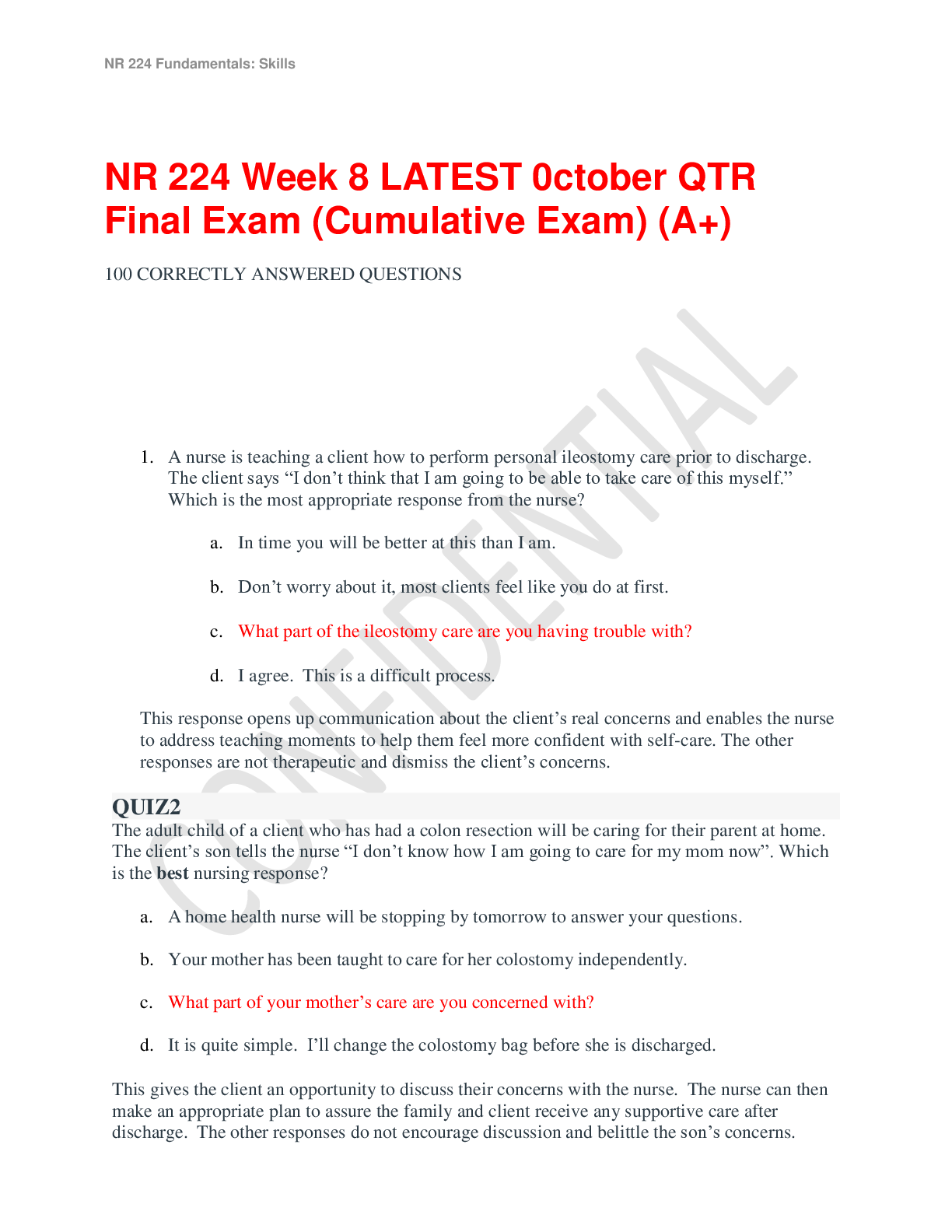






.png)
